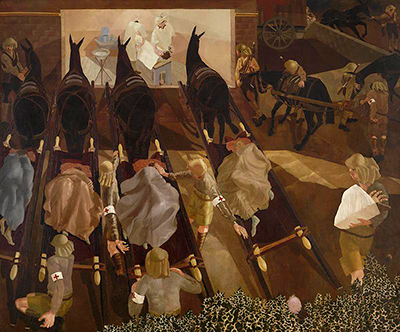One of his rare war depictions, Travoys Arriving with Wounded at a Dressing-station at Smol, Macedonia 1916 is an unusual combination on the behalf of the artist, Stanley Spencer.
While on one hand, it is a depiction of, as the title says, a relay – an endless relay, Spencer was later to recall – of injured soldiers arriving at a field first-aid station for emergency treatment during a particularly fierce battle, it is also an homage to Spencer's fiercely held Christian beliefs. This amalgamation of belief and reality was inspired by the history of one of the dressing-stations that the young Spencer worked in – he was an ambulance man upon signing up, being deemed unfit for full service, but was soon sent to Macedonia where he worked in his old position for a while before requesting – and receiving – a transfer to the infantry. The dressing station in question was a former Hellenic church, and as such the design and layout would have had an ecclesiastical flavour to it, no matter what current use it was being put to.
Spencer capitalised on this, in the painting, casting the medics and their current patient in the part of Jesus, Mary and Joseph, while the 'travoys' of the title (correctly 'travois') become the shepherds and the wise men, bringing gifts of the wounded in place of gold, frankincense and myrrh. The light of the operating room replaces the holy halo that generally illuminates depictions of the nativity. However, as religious as Spencer intended the image, and he certainly did model the positioning upon the nativity, his intentions for the religious symbology went further than a simple re-working of one Biblical event. The wounded, bound to their stretchers, Spencer saw as a representation of Christ on his cross, while the medics' work resembled that of the resurrection, returning the hope and possibility of life to those who were all but certainly doomed to death.
Spencer painted the work as a 1919 commission from the British War Memorials Committee (who fall under the Ministry of Defence) who had planned a series of artworks as a Hall of Remembrance. Sadly, the Hall of Remembrance was never fully realised, despite many of the artworks being produced. Spencer was one of the artists who completed his painting for the Hall – which was to be 'a sort of pavilion', the plans to which have been lost. The oil painted canvas, a huge 1.828 metres tall by 2.184 metres wide, is one of his largest works.




